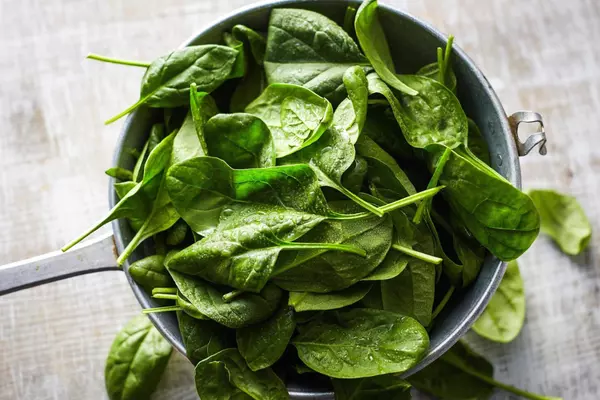Spinach is a nutritious leafy green that is packed with vitamins and minerals. It is a popular choice for salads, smoothies, and cooked dishes, but it can also go bad quickly if not stored properly.
Knowing how to tell if spinach has gone bad is important for maintaining food safety and avoiding illness.
In this blog post, we will explore the signs that spinach has gone bad and provide tips for storing it to ensure it stays fresh for as long as possible.
By following these guidelines, you can confidently enjoy spinach as a healthy and delicious part of your diet.
Can Raw Spinach Go Bad?
Yes, raw spinach can go bad. Like all fresh produce, spinach is perishable and will eventually spoil if not stored and handled properly.
A few key factors can cause spinach to go bad, including exposure to heat, light, and moisture.
How To Tell If Spinach Has Gone Bad: 5 Telltale Signs
There are several signs that spinach has gone bad, which include:
1. Wilting
If spinach has wilted and appears to be wilting, it may be past its prime. Wilting is a sign that the spinach is losing moisture and may be starting to spoil.
2. Brown Or Yellow Spots
Fresh spinach should be a vibrant green color, with no brown or yellow spots. If you notice brown or yellow spots on your spinach, it may be starting to spoil.
3. A Slimy Texture
If spinach has a slimy texture, it is a sign that it has started to break down and spoil. This sliminess is caused by bacteria and fungi that have begun to grow on the spinach.
4. A Bad Smell
Fresh spinach has a light, slightly sweet smell. If your spinach has a strong, unpleasant smell, it may be starting to spoil.
5. Discoloration
If spinach has turned an uncharacteristic color, such as brown or black, it is likely past its prime and should be discarded.
If you notice any of these signs, it is best to discard the spinach to avoid the risk of food poisoning. It is also important to handle and store spinach properly to help prevent it from going bad. This includes keeping it refrigerated, washing it thoroughly before use, and using it within a few days of purchase or harvesting.

What Does Bad Spinach Smell Like?
Fresh spinach has a light, slightly sweet smell. However, when spinach starts to spoil, it may develop a strong, unpleasant smell. This smell is caused by bacteria and fungi that are growing on the spinach as it breaks down.
How Long Does Spinach Last In A Fridge?
Spinach can last several days in the fridge if stored properly. To help extend the shelf life of spinach, it is important to keep it refrigerated and handle it with care.
Here are a few tips for storing spinach in the fridge:
- Wash the spinach thoroughly before storing it. This will help remove any dirt or contaminants that could cause the spinach to spoil more quickly.
- Dry the spinach thoroughly before storing it. Excess moisture can cause the spinach to spoil more quickly.
- Place the spinach in a plastic bag or container with a lid. This will help keep it fresh and prevent it from drying out or wilting.
- Store the spinach in the crisper drawer of your fridge. This is the part of the fridge that is specifically designed for storing produce, and it will help keep the spinach fresh and crisp.
Can You Cook Spinach That Is Going Bad?
It is generally not recommended to cook spinach that is going bad. When the spinach starts to spoil, it can develop flavors and a slimy texture, which can make it unappealing and potentially unsafe to eat.
What Happens If You Eat Bad Spinach?
Eating bad spinach can cause a variety of unpleasant symptoms and, in some cases, may even lead to serious illness.
When spinach goes bad, it can become contaminated with bacteria or other harmful microorganisms. Consuming contaminated spinach can lead to food poisoning, which can cause symptoms such as nausea, vomiting, diarrhea, abdominal cramps, and fever.
These symptoms can range from mild to severe and can last for a few days or longer, depending on the severity of the infection.
Conclusion
In conclusion, knowing how to tell if spinach has gone bad is important in maintaining food safety and avoiding illness. By paying attention to key signs of spoilage, such as wilting, brown or yellow spots, a slimy texture, and a bad smell, you can identify when spinach is no longer safe to eat. Additionally, proper storage and handling of spinach can help extend its shelf life and prevent it from going bad.
By following these guidelines, you can confidently enjoy spinach as a healthy and delicious part of your diet. Remember, if you are ever in doubt about the freshness of your spinach, it is always better to err on the side of caution and discard it to avoid the risk of food poisoning or other illness.
- Jet’s Ranch Recipe: Make The Famous Dip At Home - April 12, 2025
- James Hemings Macaroni And Cheese Recipe – History On A Plate - April 3, 2025
- French Dip Squares Recipe – Better Than A Sandwich! - March 25, 2025



1 thought on “How To Tell If Spinach Has Gone Bad: 5 Telltale Signs”